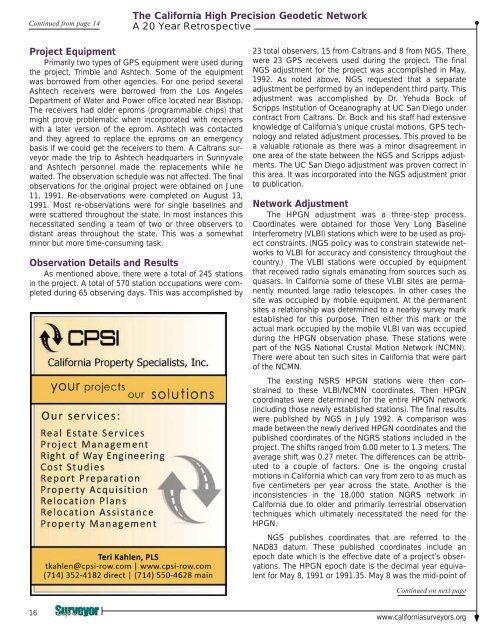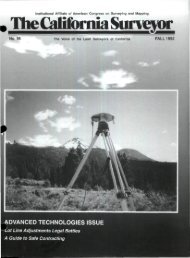You also want an ePaper? Increase the reach of your titles
YUMPU automatically turns print PDFs into web optimized ePapers that Google loves.
Continued from page 14<br />
The California High Precision Geodetic Network<br />
A 20 Year Retrospective<br />
Project Equipment<br />
Primarily two types of GPS equipment were used during<br />
the project, Trimble and Ashtech. Some of the equipment<br />
was borrowed from other agencies. For one period several<br />
Ashtech receivers were borrowed from the Los Angeles<br />
Department of Water and Power office located near Bishop.<br />
The receivers had older eproms (programmable chips) that<br />
might prove problematic when incorporated with receivers<br />
with a later version of the eprom. Ashtech was contacted<br />
and they agreed to replace the eproms on an emergency<br />
basis if we could get the receivers to them. A Caltrans surveyor<br />
made the trip to Ashtech headquarters in Sunnyvale<br />
and Ashtech personnel made the replacements while he<br />
waited. The observation schedule was not affected. The final<br />
observations for the original project were obtained on June<br />
11, 1991. Re-observations were completed on August 13,<br />
1991. Most re-observations were for single baselines and<br />
were scattered throughout the state. In most instances this<br />
necessitated sending a team of two or three observers to<br />
distant areas throughout the state. This was a somewhat<br />
minor but more time-consuming task.<br />
Observation Details and Results<br />
As mentioned above, there were a total of 245 stations<br />
in the project. A total of 570 station occupations were completed<br />
during 65 observing days. This was accomplished by<br />
23 total observers, 15 from Caltrans and 8 from NGS. There<br />
were 23 GPS receivers used during the project. The final<br />
NGS adjustment for the project was accomplished in May,<br />
1992. As noted above, NGS requested that a separate<br />
adjustment be performed by an independent third party. This<br />
adjustment was accomplished by Dr. Yehuda Bock of<br />
Scripps Institution of Oceanography at UC San Diego under<br />
contract from Caltrans. Dr. Bock and his staff had extensive<br />
knowledge of California’s unique crustal motions, GPS technology<br />
and related adjustment processes. This proved to be<br />
a valuable rationale as there was a minor disagreement in<br />
one area of the state between the NGS and Scripps adjustments.<br />
The UC San Diego adjustment was proven correct in<br />
this area. It was incorporated into the NGS adjustment prior<br />
to publication.<br />
Network Adjustment<br />
The HPGN adjustment was a three-step process.<br />
Coordinates were obtained for those Very Long Baseline<br />
Interferometry (VLBI) stations which were to be used as project<br />
constraints. (NGS policy was to constrain statewide networks<br />
to VLBI for accuracy and consistency throughout the<br />
country.) The VLBI stations were occupied by equipment<br />
that received radio signals emanating from sources such as<br />
quasars. In California some of these VLBI sites are permanently<br />
mounted large radio telescopes. In other cases the<br />
site was occupied by mobile equipment. At the permanent<br />
sites a relationship was determined to a nearby survey mark<br />
established for this purpose. Then either this mark or the<br />
actual mark occupied by the mobile VLBI van was occupied<br />
during the HPGN observation phase. These stations were<br />
part of the NGS National Crustal Motion Network (NCMN).<br />
There were about ten such sites in California that were part<br />
of the NCMN.<br />
The existing NSRS HPGN stations were then constrained<br />
to these VLBI/NCMN coordinates. Then HPGN<br />
coordinates were determined for the entire HPGN network<br />
(including those newly established stations). The final results<br />
were published by NGS in July 1992. A comparison was<br />
made between the newly derived HPGN coordinates and the<br />
published coordinates of the NGRS stations included in the<br />
project. The shifts ranged from 0.00 meter to 1.3 meters. The<br />
average shift was 0.27 meter. The differences can be attributed<br />
to a couple of factors. One is the ongoing crustal<br />
motions in California which can vary from zero to as much as<br />
five centimeters per year across the state. Another is the<br />
inconsistencies in the 18,000 station NGRS network in<br />
California due to older and primarily terrestrial observation<br />
techniques which ultimately necessitated the need for the<br />
HPGN.<br />
NGS publishes coordinates that are referred to the<br />
NAD83 datum. These published coordinates include an<br />
epoch date which is the effective date of a project’s observations.<br />
The HPGN epoch date is the decimal year equivalent<br />
for May 8, 1991 or 1991.35. May 8 was the mid-point of<br />
Continued on next page<br />
16<br />
www.californiasurveyors.org
















